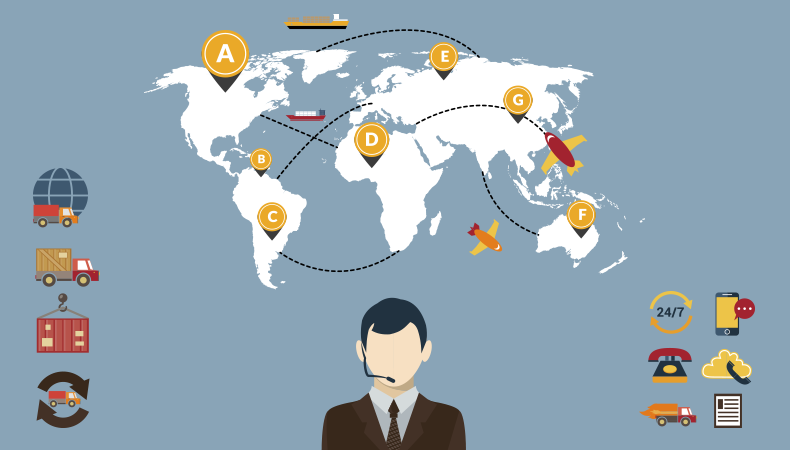Traffic and Logistics: Functions of a Traffic and Transportation Director

Logistics is an important part of various business models and therefore strict measures are taken so that it does not fall apart. Modern-day businesses also face lots of pressure from the customers and the market at large. Moreover, supply chain management has to face obstacles that are fast and unpredictable in nature. In last-mile deliveries, the director of traffic and logistics is the person who has the most influence on the success or failure of distribution processes. Not only does the entire management of transport fleets depend on this professional, but strategic planning of delivery processes also falls under the director’s responsibilities. But most day to day logistics operations are often, for the most part, handled by automated last-mile logistics software, which the director and his team set up in the beginning.
Automated logistics software can be used to monitor logistics operations of different vehicles, employees and products within the same industry. Thus such software is often now used by every major logistics corporation to increase the efficiency of delivery and increase business value. Depending on the complexity of the service, specialized features might be added to the logistics software. One example is pharmacy services, where the customer must undergo a more strict verification process because of the features present in the pharmacy delivery management software. But even though there has been significant development in automated software, there are multiple administrators supervising the process, including the director.
3 Most Important Functions of the Traffic and Transportation Director in the Logistics Process
The functions of a director of traffic and transport logistics cover a wide range. They include things such as human resources, strategic planning, supply management and process supervision. The director has many people that work under the chain of command, and they together handle all the transportation network for the company's supply chain. Following are the three most important functions of the director in detail
Analyzing and choosing vehicles to incorporate into the logistics fleet

The director of traffic and transport logistics is responsible for ensuring that the company has a vehicle fleet 100% according to its distribution needs. This is why the director and his team study what type of vehicles the company needs depending on the type of products to be transported to its customers. The travel distance and the nature of roads in the delivery areas (urban, rural, regional, national, international deliveries) also matters.
This point is important because the company must often have a large fleet of vehicles with varied load capacities, mileage and fuel requirements that must travel under harsh conditions. After lots of time researching the market and the company, the director may choose to include any number of the following different types of vehicles
- vehicles conditioned to maintain special products under harsh conditions
- Trucks, both large and small
- Vans
- Cars
- Motorcycles
- Other delivery vehicles
Therefore, the choice of vehicles to buy and incorporate is not a decision that can be taken lightly. Selecting the wrong type of vehicle can significantly increase the immediate and long-time last-mile delivery cost for the company. Once the vehicles are chosen, their details are fed into the delivery tracking system so that the deliveries are always optimized for speed and cost.
In the same manner, the director of traffic and transportation logistics is also in charge of assigning vehicles according to each distribution route. This is usually done routinely by the delivery management software automatically. It considers factors such as the number of products to be delivered on each route, the distance from the delivery points, fuel consumption, and the average time to complete the entire route for assigning the vehicles and controlling the route of delivery. Obstacles that can affect deliveries, such as traffic levels in distribution logistics and weather can also be tracked by the logistics system. This is called route optimization and is better than the traditional route planner based system which cannot handle multiple parameters.
Managing training programs for delivery agents
Delivery agents are the only staff in the logistics business whose functions are tested and carried out directly in the field (on the street). Delivery agents also must be ready to face a number of different unpredictable obstacles on a daily basis. For this reason, it is necessary for them to be professionally trained to perform their tasks very efficiently. In the case of last-mile deliveries, this includes having preparation even in customer service areas, as they often present themselves with the product on the customer’s doorstep.
Therefore, it is the responsibility of the director of traffic and transport logistics to manage different education and training programs to improve the skills and abilities of drivers in different areas. Following are the major areas in which the director is required to train the new employees who may work as delivery agents.
- Basic Transport laws
- Driving techniques in rainy climates, roads with obstacles and avoidance of traffic
- Mechanics of their vehicles
- Customer service methods
- Smart use of resources, including vehicle fuel.
- Use of the technologies implemented by the company to improve logistics transport. This includes familiarising them with delivery agent panels of the delivery software.
Improving the productivity of traffic and transport logistics in the supply chain

One of the main objectives for which a company hires a director of traffic and transport logistics is to manage and improve the strategies that help improve distribution processes in real-time. To achieve this the distribution logistics services are carefully analyzed and changes are made in the software that controls the services. These systems have functionalities for route planning, real-time tracking of vehicles through satellites, generation of performance reports and dispatch management, which are tweaked as new data from the analytics and situational analysis of ongoing deliveries are made.
The director is also regarded as the main person behind the logistics software dashboard who maximizes the effectiveness and efficiency of vehicle fleets that come under a business. The director maintains close ties with the leadership of a business and takes major decisions regarding new changes within the supply chain on their behalf.
Conclusion
As one can easily see, the transportation director is the person who is in charge of the entire fleet and delivery services in a business. Usually, the director handles major changes in the transportation system and situations where unconventional deliveries are to be made. Deliforce is a state of the art delivery management system, which records all the analytics of the delivery process. It also provides customized notifications to both the delivery agents and the customer.





